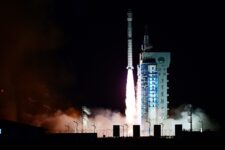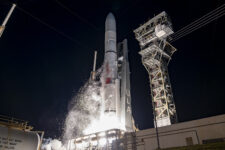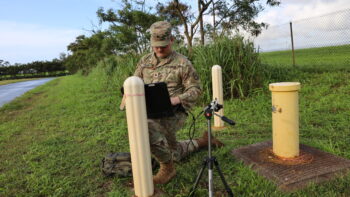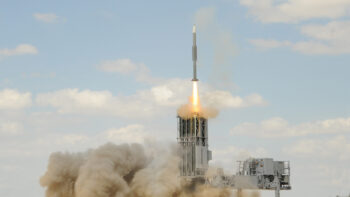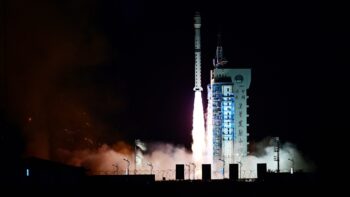
Global Sentinel participants from work together to solve challenging space scenarios during Global Sentinel 2024 at Vandenberg Space Force Base, Calif., Feb. 13, 2024. USSPACECOM and representatives from partner nations come together each year at Global Sentinel to promote cooperation and safe, secure space operations. (U.S. Space Force photo by Tech. Sgt. Luke Kitterman)
WASHINGTON — China’s experimental spaceplane Shenlong, launched to low Earth orbit (LEO) on its third mission in December, appears to have released a companion craft while in orbit — but despite close scrutiny by US Space Command and independent space watchers, it remains unclear exactly when that happened.
Astronomer Jonathan McDowell first noticed the event following the object’s listing May 25 by SPACECOM in its public database. The problem, as space watcher Bob Christy pointed out in his May 26 Orbital Focus column on X (formerly Twitter), is that if the companion had been keeping close enough to Shenlong for a few days, terrestrial radar and telescopes used to monitor the heavens would struggle to discriminate between the two. The smaller, dimmer companion simply would have been washed out by the electromagnetic signature of the larger spaceplane.
Put another way: a Chinese space vehicle released a smaller space vehicle, and no one, at least publicly, knows when or where, nor what the smaller vehicle may have done between when it was launched and when it was found. And if you are in charge of defending America’s systems in orbit, that is a terrifying proposition — and one that is of increasing concern, as space-faring nations try to game out how to hide their systems from each other.
US and allied governments, as well as commercial firms, have been racing to improve their ability to spot potential threats (both natural and deliberate) among the ever-growing satellite population: building more sensors in more locations, looking to put new ones in space, and turning to artificial intelligence and machine learning to wade through the rising tide of data. Many experts believe that this technology push is leading to a not too distant future where it will be nearly impossible for satellites to avoid prying eyes.
However, as the Shenlong example underscores, at the moment there are still ways sly operators can deliberately get lost in space at least for some period of time — perhaps long enough for their spacecraft to be able to potentially take unsafe or even nefarious actions.
And as global tensions in space continue to spiral, the stakes in the game of orbital hide and seek are high — with miscalculations and/or accidental collisions potential sparks for conflict.
Sneaky Sats: Disguises, Day Moves,
Keeping something hidden in space forever is pretty much impossible because the laws of physics on orbit dictate that, sooner or later, something will trigger today’s modern sensors, according to experts.
Still, there are both technological and operational methods for making it harder to keep a satellite in sight 24/7 — and closely co-orbiting a smaller spacecraft with a larger mothership, as Shenlong apparently did, is only one of the ways that on-orbit operations can endow a satellite some measure of unpredictability, both as to where it is at certain times and as to what its real mission is.
Technologies to minimize trackability include using radar absorbent materials and shaping to reduce a satellite’s radar cross section (just like stealth aircraft do); using non-reflective materials to present a dimmer target for a telescope to see; and dampening signals emissions. (The European Defense Fund is funding a research project to develop an stealthy inspector satellite in GEO, called NAUCRATES, using all three of those techniques.)
While it is nearly impossible for launches to go undetected, maneuvers after initial orbital insertion are common if only for stationkeeping. And maneuvers can be done in ways that allow a satellite to lose would-be trackers like a spy in a foreign country shaking a tail to get to their dead drop safely.
For example, given the paucity of sensors in the Southern Hemisphere, a Chinese satellite could make a significant move over that region that would create a challenge for SPACECOM’s 18th Space Defense Squadron both to find it again, and recalculate its new path. The faster the Chinese satellite could move and the farther away it could get from its original orbit, one expert at a commercial space monitoring firm explained, the greater that challenge would be. Even if it only took a few hours or days for US government, commercial and/or amateur sat-trackers to relocate it, the time in the wild could be enough for it to unleash some sort of attack.
“I can be moving in such a way that it is difficult for [SPACECOM] to update my position for some period of time, during which I can do something bad,” the commercial expert said.
Executing a spacecraft maneuver, or deploying a sub-satellite, during daylight hours also will flummox telescopes — a trick China’s SJ-21 pulled when it docked with a defunct Chinese bird and tugged it into a graveyard orbit back in 2022. Telescopes are looking at the brightness of a space object against a dark sky, and are essentially blind when the sun is up over their observation area.
Hiding killer satellites in plain sight by deploying them seemingly as part of a mega-constellation — something else that some experts worry about as China gears up not just one but three mega-constellations in LEO — is another way military space operators could seek to surprise adversaries with counter-space or space-to-earth weapons.
Satellites can also be disguised as space debris, drifting along silently until “woken up” near a target. As long ago as 2015, Russia’s military alleged that it had discovered spy satellites from an unnamed country pretending to be space junk while actually tapping into Moscow’s communications satellites.
The Watchers: More Eyes, Better Glasses
Of course, these threats are not unknown to the US and its allies. The increased focus on space domain awareness by the US and its allies due to growing concerns about Chinese and Russian military space activities is well documented.
Maj. Gen. Gregory Gagnon, deputy chief of space operations for intelligence, in May said the Space Force and SPACECOM have about 1,000 “priority targets” to monitor on orbit, using 600 or so sensors around the world.
DoD has been focused in particular on upping its game in the Southern Hemisphere, where it long has been short on terrestrial radar and telescopes for scanning the heavens. This includes seeking space monitoring data from commercial providers, such as LeoLabs with its four radar in that region; joint programs such as the Deep-Space Advanced Radar Capability with Australia; and better cooperation with Japan and South Korea.
DoD’s interest in partnering with other nations on space monitoring runs both ways. For example, at this year’s annual Global Sentinel exercise aimed at improving interoperability in space domain awareness, held by US Space Command in mid-February, 20 nations joined in: Australia, Belgium, Brazil, Canada, Colombia, Finland, France, Germany, Israel, Japan, Netherlands, Norway, New Zealand, Peru, Poland, Portugal, Republic of Korea, Romania, Spain, Sweden, Thailand, Ukraine and the United Kingdom. Representatives of India, Mexico and NATO also attended the last two days of the exercise as observers.
Another option is putting eyes on orbit — something the Pentagon and a growing number of commercial companies, such as Maxar and NorthStar, are increasingly interested in. Getting up close and personal to surveil a target bird can provide more information about its mission and capabilities.
The joint Space Force and National Reconnaissance Office SILENTBARKER satellites, launched last September with full operations planned to start in 2026, will stalk suspicious adversary birds in geosynchronous Earth orbit (GEO) alongside the Space Force’s older Geosynchronous Space Situational Awareness Program (GSSAP) satellites.
In the ever-more crowded LEO, DARPA last January kicked off a project called Space-domain Wide Area Tracking and Characterization, or Space-WATCH, designed to incentivize operators of large constellations for other missions to also equip their satellites for neighborhood watch duties. This January, DARPA solicited information for a second part of that project aimed at creating a highly automated fusion center for data gathered by on-orbit systems that can provide military operators with timely, actionable information.
AI for speeding tracking operations and sifting through reams of sensor data also has become an object of desire for military space operators.
For example, DARPA in March 2023 awarded three contractors — BAE Systems, Apogee Research, and Systems & Technology Research — to develop AI tools to enable autonomous tracking of space targets under a project called Oversight.
This January the agency also completed an effort with Slingshot Aerospace to create an AI software package called Agatha that can detect potentially threatening satellites lurking within large LEO constellations, the company revealed this week. The software development was part of larger project, Slingshot’s release noted.
“Agatha is designed to help find the needle in the haystack,” Audrey Schaffer, Slingshot VP of strategy and policy, told Breaking Defense on June 4.
A DARPA spokesperson said in a June 5 email that the software was the result of a “small, short duration exploratory project” designed as a “pathfinder.” A DARPA contract filing shows the value of the total Slingshot award as nearly $1 million.
Dylan Kessler, Slingshot’s director of data science, explained on June 4 that Agatha looks at parameters such as the location of satellites, their maneuvers, and how they use their communications links to find patterns of behavior that indicate if some are not doing the same mission as the others in the constellation.
The software uses data from the company’s own network of 200-plus telescopes in more than 20 locations around the world, as well as that of partner companies, SPACECOM’s Space Surveillance Network and other open source intelligence sources, Schaffer and Kessler noted.
SPACECOM leaders have repeatedly said that space domain awareness is their top priority in preparing for peer and near-peer conflict, so the Pentagon’s push to build and buy ever-sharper capabilities in unlikely to wane anytime soon. What is less openly discussed, but most assuredly underway, is a parallel push to improve the ability to keep US military and spy sats out of improving Chinese and Russian sights.
The cat and mouse game will continue, and the only way to know which side ends up winning may be if true conflict breaks out in orbit.
Space Force celebrates 5th anniversary at growing Spacepower Conference
Our latest eBook offers updates on the Space Force and SPACECOM, showcasing the latest tech, and the challenges of modern space operations.






